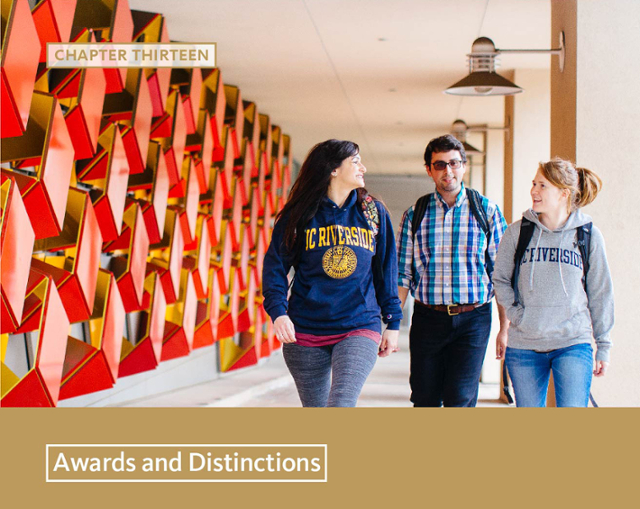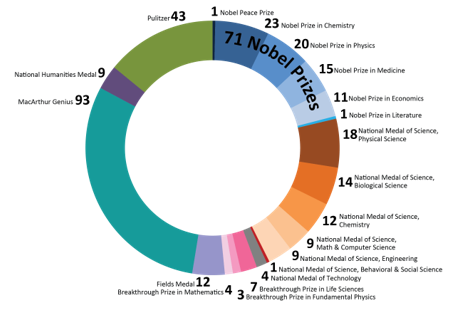Chapter 13:
Honors and Awards

For the third consecutive year, U.S. News & World Report has named UC Riverside the top university in the nation for social mobility.
The social mobility category considers the degree to which a university elevates its low-income graduates to a higher standard of living. As rankings leaders such as U.S. News have adjusted their formulas in the past few years, they increasingly consider social mobility among the leading measures of higher education success.
The campus climbed five places this year in the overall rankings, to No. 83. In the past five years, UCR has moved up 41 places in the U.S. News rankings. In its social mobility ranking, U.S. News aggregates two factors that assess the graduation rates of students who receive the Pell Grant, typically awarded to families earning less than $65,000 per year. The factors are Pell Grant six-year graduation rates and Pell Grant graduation rate performance, which considers grant recipients’ graduation rates relative to non-Pell Grant recipients’ rates. UCR's Pell Grant students‘ graduation rate is comparable to non-Pell students’ graduation rate, 77% to 76%, according to the most recent federal data available. Among UCR’s more than 26,000 students, 47% receive a Pell Grant.
"UCR’s consecutive placements as a national leader in social mobility showcase the hard work of our students and the dedication of our faculty and staff," Vice Provost and Dean for Undergraduate Education Jennifer Brown said. "It is encouraging that social mobility has become a leading indicator in college rankings, as it signals a movement toward looking at the whole student. It recognizes that all students deserve equitable outcomes in which they are successful entering and finishing college and moving on to amazing opportunities."
Overview
Honors and rankings are one way to demonstrate the University’s performance and prestige. They reflect reputations and help to position the University nationally and internationally. This chapter first presents metrics of faculty awards and memberships. These represent some of the highest aspirations of research faculty, signaling noteworthy participation and contribution to research and scholarship in a particular area of expertise. In 2021, two UC professors were awarded Nobel prizes: David Card, professor of Economics, UC Berkeley, was awarded the Economic Sciences prize and David Julius, professor of Physiology, UC San Francisco, was awarded the Physiology or Medicine prize.
While the University’s faculty demonstrate unparalleled excellence, also notable is the opportunity for students of diverse backgrounds to learn and study with these distinguished researchers and educators. One of the points of pride for the University of California is providing students from the bottom end of the economic spectrum with access to an educational and research environment comparable to the nation’s finest private institutions but on a significantly larger scale.
Universities are ranked in numerous ways, with publishers of rankings choosing criteria based on different audiences and different aims. This chapter highlights three well-known rankings. U.S. News and World Report (USNWR) focuses on academic reputation, graduation rates, student selectivity, and financial resources to create its list of America’s Best Colleges. The Shanghai Academic Ranking of World Universities ranks institutions around the globe, primarily using faculty research productivity. The Washington Monthly ranking looks at doctoral-granting research universities based on contribution to the public good. Additional rankings for UC campuses are available at the link in the section below. While recognizing that these rankings may be useful sources of information, UC does not endorse any particular ranking system nor does it have specific goals with respect to any of them.
UC faculty receive prestigious awards as leaders in their fields.
13.1.1 Nobel Prizes by campus affiliation
Seventy faculty and researchers affiliated with the University of California have won 71 Nobel Prizes, adding two new Nobel Prize winners last year.
A list of UC’s laureates can be found at nobel.universityofcalifornia.edu
|
Chemistry
|
Economics
|
Literature
|
Medicine
|
Physics
|
Peace
|
|
Berkeley/ Berkeley Lab
|
10
|
6
|
1
|
1
|
9
|
|
|
Irvine
|
2
|
|
|
|
1
|
|
|
Livermore Lab
|
|
|
|
|
1
|
|
|
UCLA
|
3
|
1
|
|
1
|
2
|
|
|
Riverside
|
1
|
|
|
|
1
|
|
|
San Diego
|
5
|
3
|
|
6
|
2
|
1
|
|
San Francisco
|
|
|
|
6
|
|
|
|
Santa Barbara
|
2
|
1
|
|
|
4
|
|
|
Santa Cruz
|
|
|
|
1 |
|
|
13.1.2 Prizes, medals, and awards won by UC faculty

In addition to the prizes, medals, and awards presented in the chart above, many UC faculty are members of prestigious National Academies, providing leadership in service and general welfare to the nation.
National Academy of Sciences: 676
National Academy of Engineering: 279
National Academy of Medicine: 260
National Academy of Inventors: 100
Of the top ten national public universities in the U.S. News and World Report ranking, six are UC campuses.
13.2.1 U.S. News: America’s Top National Public Universities, 2022
|
|
Public
|
National
|
|
UCLA
|
1
|
20
|
|
Berkeley
|
2
|
22
|
|
Santa Barbara
|
5
|
28
|
|
San Diego
|
8
|
34
|
|
Irvine
|
9
|
36
|
|
Davis
|
10
|
38
|
|
Riverside
|
33
|
83
|
| Merced |
38
|
93
|
|
Santa Cruz
|
46
|
103
|
The U.S. News and World Report, in its 2022 national university rankings, focused on academic reputation, financial resources, and selectivity in undergraduate admissions. Its assessment on these metrics placed UC campuses among the very best public universities in the country:
- UCLA and UC Berkeley were ranked first and second as the top public institutions.
- Six UC campuses were among the top ten public institutions in the nation.
- For public and private institutions combined, six UC campuses ranked among the top 50.
Numerical rankings can provide false precision based on very small actual differences among campuses. Campuses are first assigned a score, and the scores are ranked. When the scores are clustered closely, a small change in score can have a large effect on the rank.
UC campuses rank very highly among all public and private universities for social mobility.
13.2.2 U.S. News: Top Performers on Social Mobility, 2022
|
Riverside
|
1
|
|
Irvine
|
2
|
|
Merced
|
4
|
|
Santa Cruz
|
12
|
|
Davis
|
16*
|
|
Santa Barbara
|
16*
|
|
UCLA
|
21
|
|
San Diego
|
26
|
|
Berkeley
|
82
|
*tie
The social mobility rankings are based on two ranking factors — Pell Grant graduation rates and Pell Grant graduation rate performance. As quoted on usnews.com/education/best-colleges/articles/how-us-news-calculated-the-rankings:
“Pell Grant graduation rates incorporate six-year graduation rates of Pell Grant students, adjusted to give much more credit to schools with larger Pell student proportions. This is computed as a two-year rolling average.
“Pell Grant graduation rate performance compares each school’s six-year graduation rate among Pell recipients with its six-year graduation rate among non-Pell recipients by dividing the former into the latter, then adjusting to give much more credit to schools with larger Pell student proportions. The higher a school’s Pell graduation rate relative to its non-Pell graduation rate up to the rates being equal, the better it scores. This, too, is computed as a two-year rolling average.”
Four UC campuses appear in the top 25 of the Academic Rankings of World Universities.
13.2.3 Shanghai Ranking Consultancy: Academic Rankings of World Universities, 2021
|
|
Global
|
National |
|
Berkeley
|
5
|
4
|
|
UCLA
|
14
|
11
|
|
San Diego
|
18
|
14
|
|
UCSF
|
20
|
16
|
|
Santa Barbara
|
57
|
31
|
|
Irvine
|
70
|
35
|
|
Davis
|
100
|
40
|
|
Santa Cruz
|
151-200
|
57-62
|
|
Riverside
|
201-300
|
63-89
|
|
Merced
|
401-500
|
111-129
|
The Academic Rankings of World Universities (ARWU) was created in 2003 by Shanghai Jiao Tong University in China to determine the global standing of Chinese research universities. Since 2009, the Shanghai Ranking Consultancy has published these rankings.
The rankings are based entirely on measures of research strength and faculty honors and awards. English-speaking universities, especially those in the United States, tend to dominate the ARWU rankings.
This ranking system emphasizes research outputs, such as total research expenditures. Because research outputs are not normalized by number of faculty, larger institutions tend to rank more highly than smaller ones. Institutions with strong research programs, especially in the sciences, also tend to score higher than those whose major strengths are in the humanities and social sciences.
13.2 RANKINGS
Washington Monthly ranked six UC campuses in the top 50 institutions.
13.2.4 Washington Monthly Research University Ranking, 2021
|
National |
| Berkeley |
10 |
| San Diego |
12 |
| Davis |
14 |
| UCLA |
22 |
| Irvine |
44 |
| Santa Barbara |
49 |
| Riverside |
53 |
| Santa Cruz |
80 |
| Merced |
103 |
Washington Monthly ranks “National universities — four-year institutions that award a significant number of doctoral degrees — based on their contribution to the public good in three broad categories: social mobility, research, and promoting public service.”

